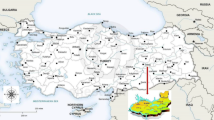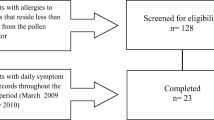Abstract
This study aims to establish themathematical relationship between allergenicpollen in the air and clinical cases ofpollinosis (hay fever) in humans, and toevaluate the immediate effect of wind and rainon such cases. The pollen was collected inFigueres, Catalonia, Spain (42°30′ Nand 3° E), through a filtration method,in the spring of 1998. Skin tests revealed thatthe antigenic taxa are Olea europaea,Plantago sp., Parietaria officinalisand Gramineae. A linear correlation –with the number of days with presence of pollenas the abscissa and the number of days withcoincidence of pollinosis as the ordinate – wasperformed. The linear correlation coefficientwas 0.9285, at the limit of a directcorrelation by two degrees of freedom.Furthermore, a negative relationship wasobserved between the number of days with rainand number of days with pollinosis, and apositive relationship between the number ofdays with fixed wind speed and number of dayswith pollinosis.
Similar content being viewed by others
References
Gregory P.H.: 1973, Microbiology of the Atmosphere, 2nd edition. Leonard Hill Books, London.
Hamilton E.D.: 1959, Studies on the air spora. Acta Allergologica 13, 143-175.
Márquez J.: 1996, Estudio del componente palinológico de la atmósfera de Vitoria y su incidencia en la salud pÚblica. Tesi doctoral, Universitat de Barcelona.
Martin J.: 1988, Estudi del pol·len aerovagant de Barcelona. Tesi doctoral, Universitat de Barcelona.
Martin J., Suárez-Cervera M. and Seoane-Camba J.A.: 1990, Influencia de los factores climáticos en la captura del polen aerovagante. In: Polen, esporas y sus aplicaciones. VII Simposio de Palinología de la Asociación de Palinólogos en Lengua Española. Granada, pp. 385-390.
McDonald M.S.: 1979, The effects of meteorological conditions on the concentration of airborne pollen over an estuarine area. Pollen et Spores 21, 233-238.
McDonald M.S. and O'Driscolli B.J.: 1980, Aerobiological seasons of widely differing weather conditions. Clinical Allergy 10, 211-215.
Suárez-Cervera M. and Seoane-Camba J.A.: 1983, Estudio del contenido polínico de la atmósfera de Barcelona segÚn un nuevo método de filtración. Collectanea Botanica 14, 587-615.
Suárez-Cervera M. and Seoane-Camba J.A.: 1985, Sobre el sistema de filtración automática en aerobiología. Anales de la Asociación de Palinólogos en Lengua Española 2, 307-317.
Tornevik H.: 1984, Aerobiological modelling. Nordic Aerobiology. 5th Nordic Symposium on Aerobiology. Abisko 1983, 62-65.
Author information
Authors and Affiliations
Corresponding author
Rights and permissions
About this article
Cite this article
Riera, M.D., Cerdà, M.T. & Martín, J. A correlation study between airborne pollen and cases of pollinosis in humans. Aerobiologia 18, 169–173 (2002). https://doi.org/10.1023/A:1021373422767
Issue Date:
DOI: https://doi.org/10.1023/A:1021373422767




